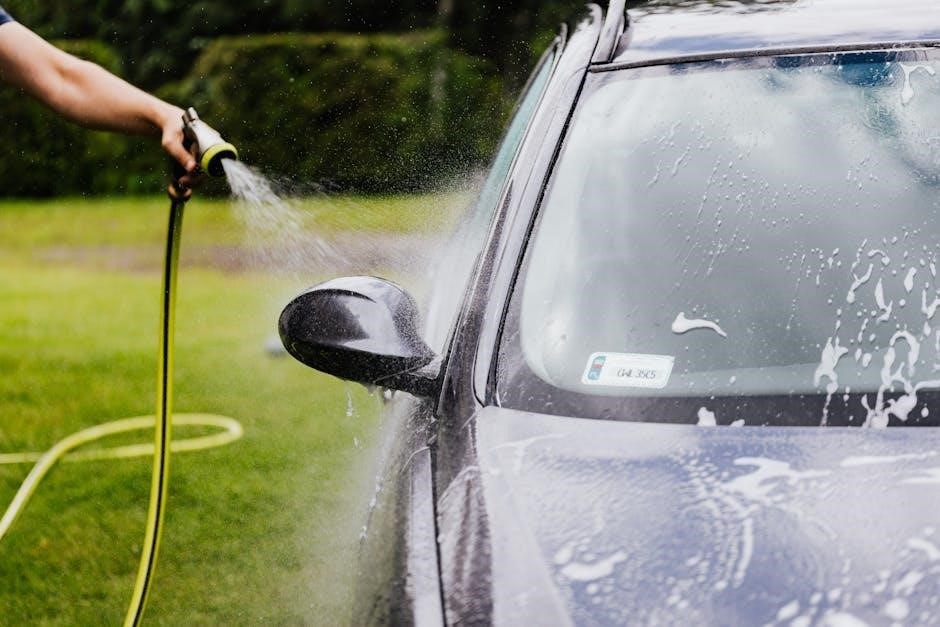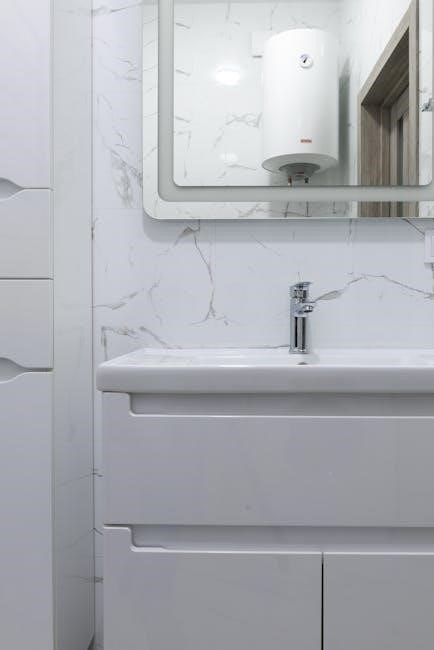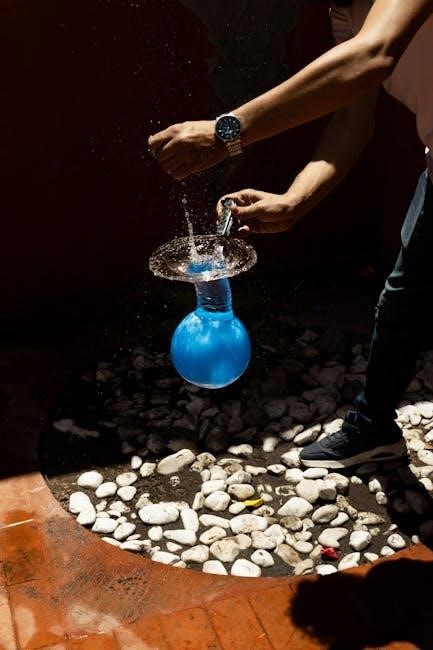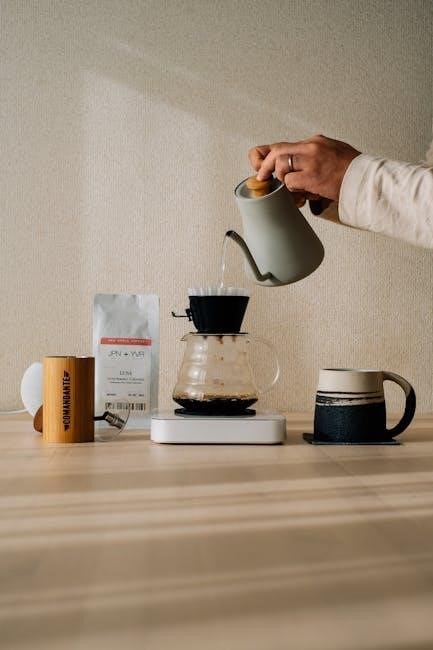
bosch tankless water heater manual
Welcome to the Bosch Tankless Water Heater Manual, your comprehensive guide for installation, maintenance, and troubleshooting․ This manual ensures optimal performance, efficiency, and safety for your Bosch tankless water heater, helping you maximize its benefits while adhering to safety guidelines and manufacturer recommendations․
Overview of Bosch Tankless Water Heaters
Bosch tankless water heaters are innovative, energy-efficient solutions designed to provide continuous hot water on demand․ These units are compact, space-saving alternatives to traditional tank-style heaters, offering superior performance and durability․ Bosch models are known for their advanced technology, including modulating burners and smart sensors, which optimize energy use and water temperature control․ They are suitable for residential and light commercial applications, catering to varying water demand needs․ With a focus on sustainability, Bosch tankless water heaters reduce energy consumption and lower operating costs, making them a popular choice for eco-conscious homeowners․ Their reliability and long lifespan further enhance their appeal․
Importance of the Manual for Installation and Maintenance
The Bosch tankless water heater manual is essential for ensuring safe, correct, and efficient installation and maintenance․ It provides detailed instructions to help users and professionals avoid common mistakes that could lead to system damage or safety hazards․ The manual includes troubleshooting guides, maintenance schedules, and technical specifications to keep the heater operating at peak performance․ By following the manual, users can optimize energy efficiency, extend the heater’s lifespan, and ensure compliance with safety standards․ Regular maintenance, as outlined, prevents issues like scaling or ignition problems, while proper installation guarantees reliable operation and warranty validity․
Installation Requirements and Precautions
Proper installation ensures safety and efficiency․ Follow guidelines for location, venting, gas supply, and electrical connections to prevent hazards and ensure optimal performance․ Always comply with local codes and manufacturer standards to avoid issues․
Pre-Installation Checklist and Safety Measures
Before installing your Bosch tankless water heater, ensure the location is well-ventilated and meets local building codes․ Verify gas and water supply lines are compatible and undamaged․ Check electrical connections for proper voltage and grounding․ Ensure the area is clear of flammable materials and that a suitable drain pan is in place․ Wear protective gear, including gloves and safety glasses․ Shut off all utilities before starting work․ Always follow the manufacturer’s instructions and consult a licensed professional if unsure․ Proper preparation ensures a safe and successful installation․ Adhere to all safety guidelines to prevent accidents․
Step-by-Step Installation Guide
Mount the Bosch tankless water heater on a flat, sturdy surface, ensuring proper ventilation․ Connect the water inlet and outlet lines, securing them tightly to avoid leaks․ Install the gas line, ensuring it matches the unit’s specifications․ Connect the venting system according to local codes and manufacturer guidelines․ Attach the electrical connections, verifying the correct voltage․ Activate the water and gas supplies and test the unit by running hot water․ Check for leaks and proper ignition․ Ensure all connections are secure and functioning correctly․ Follow the manual for precise configurations and settings․ Always turn off utilities before performing any adjustments․

Operating Instructions for Bosch Tankless Water Heaters
Turn on the unit, check indicator lights, and ensure water flow․ Adjust temperature settings as needed using the control panel․ Monitor flow rate and maintain balance for consistent performance․ Always follow safety guidelines and shut off when not in use․ Regularly review the manual for optimal operation․
Initial Setup and Configuration
Begin by unpacking and placing the heater in a well-ventilated area․ Connect the water and gas lines securely, ensuring proper alignment and sealing․ Check for leaks using a soap solution․ Install the temperature control unit and link it to the heater․ Set the default temperature to your preference, typically between 100°F and 120°F․ Power on the unit and allow it to initialize․ Run a test cycle to ensure proper function; Refer to the manual for specific configuration steps tailored to your model․ Ensure all safety features are activated and test the shut-off mechanisms․ Proper setup ensures safe and efficient operation․
Daily Operation and Temperature Control
Turn on the Bosch tankless water heater by setting the temperature control unit to your desired level․ Use the control panel to adjust settings, ensuring the temperature is between 100°F and 120°F for optimal performance․ Monitor the flow rate to maintain consistent water temperature․ Regularly check the inlet water temperature to avoid overheating․ For energy efficiency, lower the temperature when demand is low․ Always follow the manual’s guidelines for temperature adjustments․ Ensure proper ventilation during operation to prevent gas buildup․ Regularly inspect and clean the filter to maintain efficiency․ Adjust settings as needed to balance comfort and energy savings․ Proper daily operation ensures reliable and efficient performance․

Maintenance and Care Tips
Regularly clean filters and inspect venting systems to ensure optimal performance․ Check for leaks and mineral buildup, descale if necessary․ Perform annual professional inspections․
Regular Maintenance Tasks for Optimal Performance
To ensure your Bosch tankless water heater operates efficiently, perform regular maintenance․ Inspect and clean the air intake and venting systems to prevent blockages․ Check for leaks in water and gas connections․ Descaling the heater every 6-12 months is crucial, especially in hard water areas, to remove mineral buildup․ Replace the filter annually or as needed․ Check the temperature and pressure relief valves to ensure proper function․ Schedule annual professional servicing to maintain warranty validity and performance․ Monitor the control panel for error codes and address them promptly․ Always refer to the manual for specific guidance․
Replacing Parts and Filters
Regularly replacing parts and filters ensures your Bosch tankless water heater operates efficiently․ Start by turning off the power and water supply before any replacement․ Replace the water filter every 6-12 months to maintain water quality and flow․ Inspect seals and gaskets annually; replace them if worn or leaking․ The anode rod should be checked every 3 years and replaced if corroded․ Use genuine Bosch parts for compatibility and performance․ Refer to your manual for specific part numbers and replacement procedures․ If unsure, consult a professional․ Proper replacements prevent damage and extend the heater’s lifespan․ Always follow safety guidelines during replacements․

Troubleshooting Common Issues
Identify issues like error codes, no hot water, or inconsistent temperatures․ Check gas supply, water flow, and venting․ Reset the unit or replace faulty parts if necessary․ Consult the manual for diagnostic procedures․ If problems persist, contact a certified technician for professional assistance․ Regular maintenance can prevent many common issues․ Always follow safety guidelines when troubleshooting․
Identifying and Diagnosing Potential Problems
Start by checking for error codes on the display, which indicate specific issues like ignition failures or temperature extremes․ Verify the gas supply is open and water flow rates are within recommended levels․ Inspect for blockages in water inlet filters or venting systems․ Ensure proper installation of heat exchangers and condensate drainage․ Consult the manual for detailed diagnostic charts and fault code meanings․ Perform a system reset if necessary․ If issues persist, contact a certified technician to avoid further complications․ Regular checks can help prevent minor problems from escalating․ Always follow safety guidelines during diagnostics․
Solutions for Common Faults and Errors
Start by referencing the error codes displayed on the unit to identify the issue․ For ignition failures, ensure the gas supply is adequate and check for blockages in the burner․ If water temperature is inconsistent, adjust the flow rate or check for mineral buildup․ Clear error codes by resetting the unit․ Descale the heater if lime scale accumulation is detected․ Replace worn-out parts like seals or sensors as needed․ Ensure proper ventilation and check for gas leaks․ If issues persist, consult the manual or contact Bosch customer support for professional assistance․ Always follow safety guidelines during repairs․

Safety Precautions and Warnings
Always follow installation and operation guidelines to ensure safe use․ Keep flammable materials away from the heater․ Avoid tampering with internal components․ Ensure proper ventilation to prevent carbon monoxide buildup․ Never operate the heater near open flames or sparks․ Keep children and pets away from hot surfaces․ Regularly inspect gas and electrical connections for leaks or damage․ If unusual noises or odors occur, shut off the unit and consult a professional․ Adhere to all local safety codes and regulations․
General Safety Guidelines
Always follow Bosch’s safety guidelines to ensure safe operation․ Keep the area around the heater clear of flammable materials․ Ensure proper ventilation to prevent carbon monoxide buildup․ Never modify the heater or its components without authorization․ Avoid using the heater near open flames or sparks․ Keep children and pets away from hot surfaces and controls․ Regularly inspect gas lines and electrical connections for leaks or damage․ If you notice unusual odors or sounds, shut off the heater immediately․ Always adhere to local safety codes and manufacturer recommendations for installation and maintenance․
Emergency Procedures and Shutdown
In case of an emergency, immediately shut off the gas supply and electrical power to the heater․ Close the main water shut-off valves to stop water flow․ Open windows for ventilation if you suspect a gas leak․ Do not attempt to restart the heater until a qualified technician inspects it․ If you notice excessive temperature, unusual noises, or gas odors, evacuate the area and contact emergency services․ Keep a fire extinguisher nearby․ Never restart the heater after an emergency unless instructed by a professional․ Always follow local emergency protocols and Bosch’s recommended procedures for safe shutdown․

Technical Specifications and Compatibility
Bosch tankless water heaters feature variable settings, high-efficiency ratings, and compatibility with both gas and electric systems․ Models vary in power, flow rates, and energy consumption, ensuring suitability for diverse plumbing setups and household needs․
Understanding the Heater’s Technical Details
Bosch tankless water heaters are designed with advanced technology, offering precise temperature control and energy-efficient operation․ They typically feature flow rates between 2-10 GPM and temperature ranges of 100°F to 140°F․ Models are available in gas and electric configurations, with varying power inputs to suit different household demands․ The heaters incorporate sensors for automatic shut-off, overheat protection, and freeze prevention; They are also equipped with digital controls for easy adjustment of settings․ Understanding these technical details helps users optimize performance, ensure safety, and select the most suitable model for their specific water heating needs;
Compatibility with Various Plumbing Systems
Bosch tankless water heaters are designed to integrate seamlessly with most plumbing systems, including copper, PEX, and PVC piping․ They are compatible with a wide range of water pressure levels, typically operating effectively between 15 PSI and 150 PSI․ The heaters’ compact design allows for flexible installation in both retrofit and new construction projects․ Additionally, they can be paired with standard water softeners or filtration systems to enhance water quality․ Proper venting is essential for gas models, requiring Category III venting to ensure safe and efficient operation․ Compatibility with existing plumbing systems makes Bosch tankless water heaters a versatile choice for homeowners․
Factors Influencing Heater Performance
Factors influencing Bosch tankless water heater performance include temperature settings, water flow rate, gas supply, and ventilation․ Inlet water temperature and water hardness also impact efficiency․
Water Temperature and Flow Rate
The performance of your Bosch tankless water heater is significantly influenced by water temperature and flow rate․ The heater’s ability to maintain consistent temperatures depends on the incoming water temperature, which varies by region․ Higher flow rates may require adjustments to avoid temperature drops․ Proper balancing ensures sufficient hot water delivery without overloading the system․ Maintaining optimal flow rates prevents pressure drops and ensures efficient heating․ Always follow the manufacturer’s guidelines for temperature settings to achieve the best performance and energy efficiency․ Regular monitoring helps maintain ideal conditions for reliable operation․
Gas Supply and Ventilation Requirements
Ensuring proper gas supply and ventilation is crucial for the safe and efficient operation of your Bosch tankless water heater․ The heater requires a steady gas supply, and the gas line must be appropriately sized and installed according to Bosch specifications․ Proper ventilation is essential to remove combustion byproducts like carbon monoxide․ Always use approved venting materials and ensure the system complies with local building codes․ Improper installation can lead to safety hazards or reduced performance․ Regular inspections of gas lines and ventilation systems are recommended to maintain safety and efficiency․ Adhere to Bosch’s guidelines for optimal functionality and compliance․
Energy Efficiency and Cost Savings
Bosch tankless water heaters offer energy efficiency and cost savings by only heating water when needed, reducing energy bills․ High EF ratings ensure eco-friendly, long-term savings, lowering environmental impact․
Energy Efficiency Ratings and Benefits
Bosch tankless water heaters boast high Energy Factor (EF) ratings, often exceeding 0․90, ensuring superior energy efficiency; These ratings translate to significant cost savings by reducing energy consumption․ By heating water only when needed, these units minimize standby heat loss, a common issue with traditional tank heaters․ This on-demand heating not only lowers utility bills but also reduces environmental impact․ Additionally, Bosch models with high EF ratings qualify for Energy Star certification, offering rebates and incentives․ Long-term savings are further enhanced by the heaters’ extended lifespan compared to conventional systems, making them a smart investment for eco-conscious homeowners․
Long-Term Cost Savings and Environmental Impact
Bosch tankless water heaters offer substantial long-term cost savings by reducing energy consumption and lasting significantly longer than traditional tank-style heaters․ Their extended lifespan reduces replacement frequency, lowering overall ownership costs․ Environmentally, these heaters produce fewer greenhouse gas emissions due to their high efficiency․ By minimizing energy waste, they contribute to a smaller carbon footprint․ Additionally, Bosch’s eco-friendly designs align with sustainable living practices, making them a responsible choice for homeowners․ Over time, the combination of energy savings and reduced environmental impact creates a compelling case for investing in Bosch tankless water heaters․

Bosch Tankless Water Heater Models
Bosch offers a wide range of tankless water heater models, each designed for specific needs, ensuring high efficiency, reliable performance, and innovative technology for optimal water heating solutions․
Comparison of Different Bosch Models
Bosch offers a variety of tankless water heater models, catering to different needs and preferences․ Gas-powered models, such as the Bosch Therm C 1210, are known for high flow rates and energy efficiency․ Electric models, like the Bosch Tronic 3000, provide compact designs and lower installation costs․ Residential models are designed for single-family homes, while commercial models, like the Bosch Therm C 199, offer higher capacity for larger demands․ Each model varies in flow rate, energy efficiency, and temperature control, ensuring users can select the best fit for their household or business needs․ Advanced features like digital controls and remote access add convenience․
Choosing the Right Model for Your Needs
Selecting the appropriate Bosch tankless water heater model depends on your household size, water usage patterns, and available fuel options․ Assess your peak demand by calculating the number of simultaneous hot water uses․ Gas models are ideal for high-demand households, while electric models suit smaller needs․ Consider space constraints and installation requirements․ Budget and desired energy efficiency ratings also play a role․ Bosch offers tools like the sizing calculator to help determine the best model․ Ensure compatibility with your plumbing system and local regulations․ Prioritize features like temperature control, remote access, and noise reduction based on personal preferences․ Research warranties and customer support options to make an informed decision․

Accessories and Additional Features
Bosch offers various accessories, such as temperature control remotes and mounting brackets, to enhance functionality․ Additional features include smart technology integration for remote monitoring and energy management․
Recommended Accessories for Enhanced Functionality
Bosch offers a range of recommended accessories to optimize your tankless water heater’s performance․ A temperature control remote allows for precise temperature adjustments from a distance, enhancing user convenience․ Mounting brackets ensure secure installation and save space, while water filters prevent limescale buildup, maintaining efficiency․ Additionally, venting kits are available to ensure proper gas ventilation and meet safety standards․ These accessories are designed to enhance functionality, safety, and overall user experience, making them essential for maximizing the benefits of your Bosch tankless water heater system․
Optional Features for Customized Performance
Bosch tankless water heaters offer optional features to tailor performance to your needs․ Wi-Fi connectivity enables remote monitoring and control via smartphone apps, while an external temperature sensor provides precise monitoring․ A scale mitigation system reduces mineral buildup, extending lifespan․ High-altitude kits ensure proper operation in elevated areas․ Custom settings, like priority water heating for specific taps, enhance flexibility․ Energy-saving modes reduce standby heat loss, improving efficiency․ These optional features allow you to customize your Bosch tankless water heater for optimal performance, convenience, and energy savings, ensuring a system tailored to your specific requirements․

Common Mistakes to Avoid
Common mistakes include improper installation, ignoring maintenance, incorrect sizing, and not following safety guidelines․ These errors can lead to reduced efficiency, safety hazards, and system damage․
Installation and Maintenance Mistakes
Common installation mistakes include improper venting, incorrect unit sizing, and not following manufacturer guidelines․ Maintenance errors involve neglecting filter cleaning, ignoring leak checks, and delaying part replacements․ Improper electrical connections, misconfigured temperature settings, and using incompatible materials can also lead to performance issues․ Always ensure proper installation by a certified technician and adhere to Bosch’s maintenance schedules․ Ignoring these steps can result in reduced efficiency, higher energy bills, and potential safety risks․ Regular inspections and timely repairs are crucial for optimal performance and longevity of the water heater․
Operational Errors and How to Prevent Them
Common operational errors include improper temperature setting, ignoring error codes, and not adjusting for water hardness․ Users may also forget to inspect flow sensors or bypass valves․ To prevent these issues, always follow the manual’s guidelines for temperature calibration and error code troubleshooting․ Regularly clean filters and descale the unit to maintain performance; Ensure remote controllers are properly paired and configured․ Monitoring water pressure and flow rates can also help avoid unexpected shutdowns․ Lastly, always schedule professional checks if persistent issues arise, as DIY repairs may void the warranty or cause further damage․

Customer Support and Warranty Information
Bosch offers customer support through phone, email, and their website․ The warranty covers parts and heat exchangers for up to 5 years, ensuring satisfaction when properly installed․
Contacting Bosch Customer Service
Bosch provides multiple ways to contact their customer service team for assistance with tankless water heaters․ Users can reach out via phone, email, or live chat through the official Bosch website․ The customer service hotline is available during business hours, and representatives are trained to address technical issues, installation queries, and maintenance concerns․ Additionally, the Bosch website offers a comprehensive support section with FAQs, troubleshooting guides, and downloadable resources like manuals and brochures․ For faster assistance, customers are encouraged to have their model number and purchase details ready when contacting support․ Bosch also offers 24/7 online support for urgent inquiries․
Understanding Warranty Terms and Conditions
Bosch tankless water heaters come with a comprehensive warranty program designed to protect your investment․ The warranty typically covers parts and labor for a specified period, usually ranging from 5 to 15 years, depending on the model and components․ Proper registration within 30 days of installation is often required to activate the warranty․ Coverage may exclude damage caused by improper installation, scaling, or lack of maintenance․ It’s essential to review the terms and conditions to understand what is covered and what is not․ Keep all documentation, including receipts and maintenance records, to ensure warranty claims are processed smoothly․ Regular maintenance is key to maintaining warranty validity․


Leave a Reply
You must be logged in to post a comment.